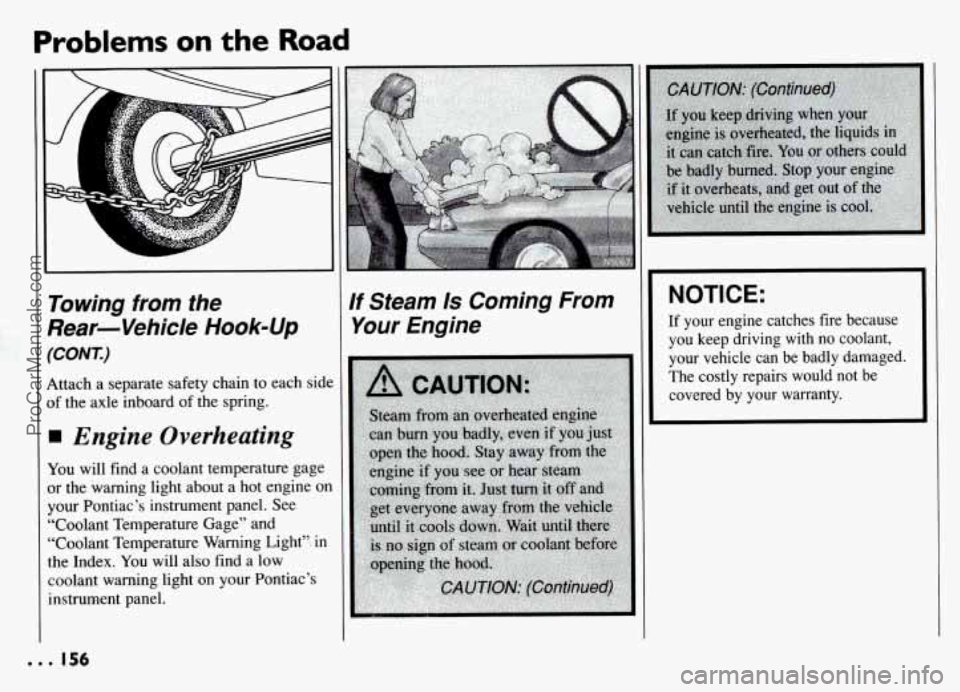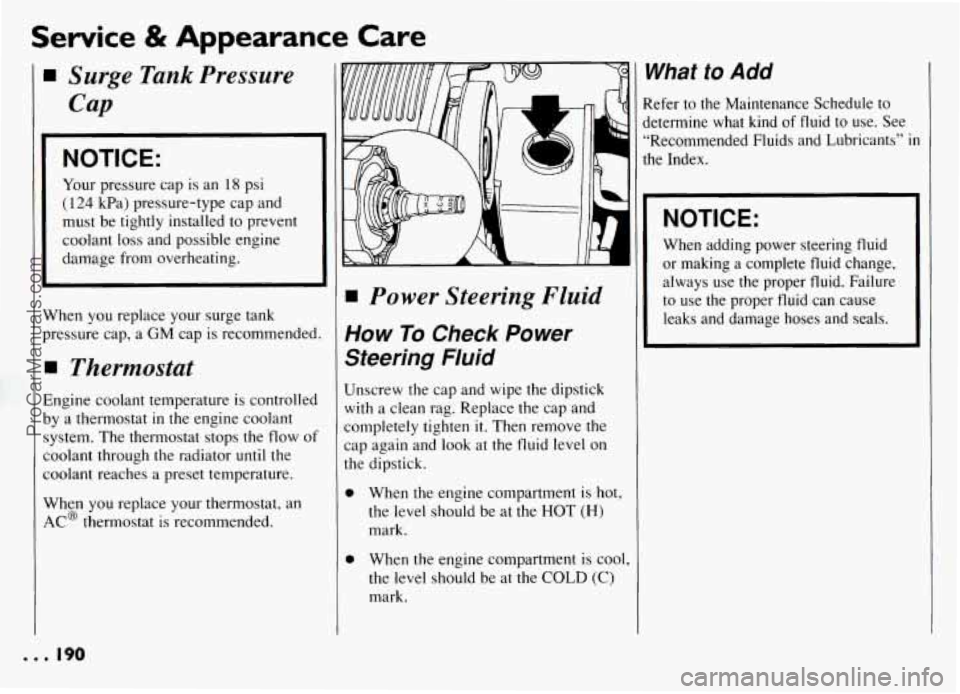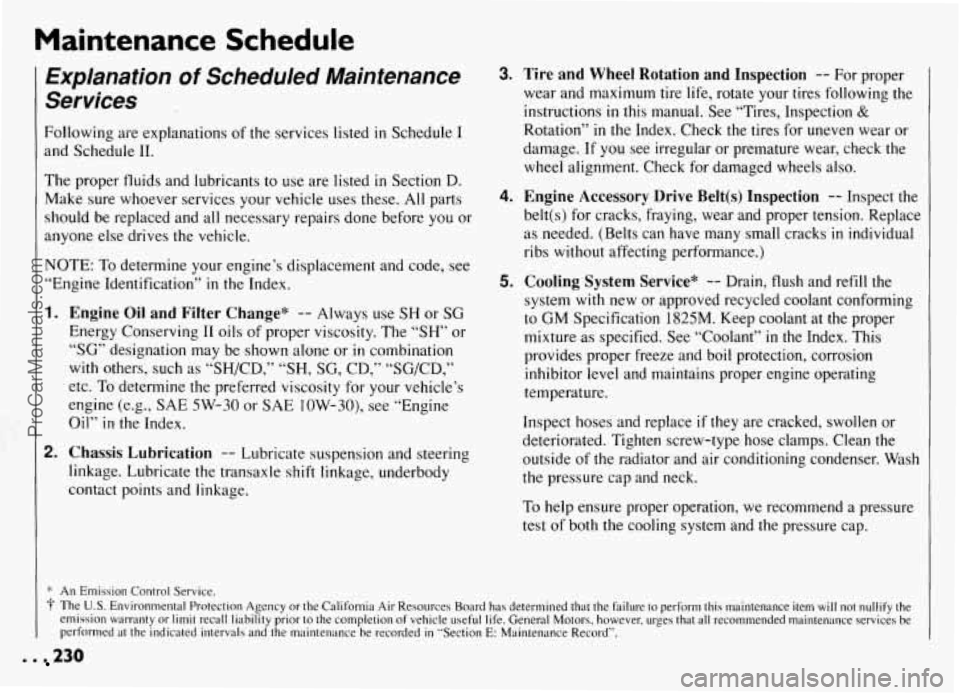1994 PONTIAC GRAND-AM coolant temperature
[x] Cancel search: coolant temperaturePage 95 of 274

Features & Controls
Fuel Gage (CONT.)
0 It takes a little more or less fuel to fill
up than the gage indicated. For
example, the gage may have indicated
the tank was half full, but it actually
took a little more or less than half the
tank’s capacity to fill the tank.
0 The gage moves a little when you turn
a corner or speed up.
0 The gage doesn’t go back to “E” when
you turn off the ignition.
For your fuel tank capacity, see “Service
Station Information”
on the last page of
this manual.
Engine Coolant Temperature Warning
Light
This light tells you that your engine
coolant has overheated or your radiator
cooling fan is not working.
If you have been operating your vehicle
under normal driving conditions, you should pull
off the road, stop your vehicle
and
turn the engine off as soon as possible
HOT COOLANT CAN BURN YOU
BADLY!
In “Problems on the Road”, this manual
shows what to do. See “Engine
Overheating” in the Index.
Engine Coolant
Temperature Gage
This gage shows the engine coolant
temperature. If the gage pointer moves
into the red area, your engine is too hot!
That reading means the same thing as the
warning light. It means that your engine
coolant has overheated.
If you have been operating your vehicle
under normal driving conditions, you
should pull
off the road, stop your vehicle
and
turn off the engine as soon as possible.
HOT COOLANT CAN BURN YOU
BADLY!
In “Problems on the Road”, this manual shows what to do. See “Engine
Overheating” in the Index.
ProCarManuals.com
Page 103 of 274

I’
Comfort Controls & Audio Systems
w Climate Control System
With this system, you can control the
ventilation and heating
in your vehicle.
Your vehicle also has the flow-through
ventilation system described later
in this
section.
. . . 102
# : The left control knob sets the fan
speed. To select the force of air you want,
turn the knob. The fan is always running
unless the mode control is moved to
OFF.
Temperature Control: The center
control regulates the temperature of the
air coming through the system.
Mode Control: The right control knob
:hanges the functions of your system.
’(rr (Bi-Level): Use on cool, but sunny
days. This setting brings
in the outside ai
but directs it
in two ways. The cool air is
directed to the upper portion
of your bod
through the instrument panel outlets, but
slightly warmer air is directed through th
heater ducts and defroster vents. At time:
this temperature difference may be more
apparent than others.
(rr (Vent): Use when outside
temperatures are mild, and little heating
or cooling
is needed. Air flow is through
the instrument panel outlets. Set the
center control knob to the temperature
desired.
A.
A.
p(rr (Heater): This setting directs air
ihrough the heater ducts toward your feet
and the floor, and some through the
windshield defroster vents.
[f you have the optional engine coolant
heater (engine block heater) and use it
during cold weather,
0°F (- 18 “C) or
lower, your heating system
will more
quickly provide heat because the engine
coolant is already warm.ed. See “Engine
Coolant Heater (Engine
Block Heater)’’
in the Index.
%?a FrJ (Blend): This setting divides air flow
equally between the heater ducts and the
windshield defroster vents.
(Defrost): This setting directs most
air through the windshield defroster vents,
and some through the heater ducts.
Defogging Windows
To defog the windshield, turn all three
control knobs to the far right.
ProCarManuals.com
Page 157 of 274

Problems on the Road
Towing from the
Rear-Vehicle
Hook-Up
(CONT.)
Attach a separate safety chain to each side
of the axle inboard of the spring.
Engine Overheating
You will find a coolant temperature gage
or the warning light about a hot engine on
your Pontiac’s instrument panel. See
“Coolant Temperature Gage” and
“Coolant Temperature Warning Light”; in
the Index. You will also find
a low
coolant warning light
on your Pontiac’s
instrument panel.
If Steam Is Coming From
Your Engine NOTICE:
If your engine catches fire because
you keep driving with no coolant,
your vehicle can be badly damaged.
The costly repairs would not be
covered by your warranty.
ProCarManuals.com
Page 189 of 274

Service & Appearance Care
How to Check:
The proper fluid should be added if the
level is at or below the STEP mark on the
reservoir cap. See the instructions on the
reservoir cap.
Engine Coolant
The following explains your cooling
system and how to add coolant when
it is
low.
If you have a problem with engine
overheating, see “Engine Overheating”
in
the Index,
The proper coolant for your Pontiac will:
Give freezing protection down to
-34°F (-37°C).
Give boiling protection up to 262°F
( 128 “C).
Protect against rust and corrosion.
Help keep the proper engine
temperature.
Let the warning lights work as they
should.
What to Use
Use a mixture of one-half clean water
(preferably distilled) and one-half
antifreeze that meets “GM Specification
1825-M,” which won’t damage aluminum
parts.
You can also use a recycled coolant
conforming to GM Specification 1825-M
with a complete coolant flush and refill. If
you use this mixture, you don’t need to
add anything else. NOTICE:
If you use an improper coolant mix,
your engine could overheat and be
badly damaged. The repair cost
wouldn’t be covered by your
warranty. Too much water
in the
mix can freeze and crack the engine,
radiator, heater core and other parts.
... 188
ProCarManuals.com
Page 191 of 274

Service & Appearance Care
V
P
I
E
b
S’
C
C.
P
A
I Surge Tank Pressure
Cap
NOTICE:
Your pressure cap is an 18 psi
( 124 kPa) pressure-type cap and
must be tightly installed to prevent
coolant
loss and possible engine
damage from overheating.
irhen you replace your surge tank
ressure cap, a GM cap is recommended.
I Thermostat
lngine coolant temperature is controlled
y a thermostat in the engine coolant
ystem. The thermostat stops the flow
of
oolant through the radiator until the
oolant reaches a preset temperature.
Jhen you replace your thermostat, an
.C@ thermostat is recommended.
Power Steering Fluid
How To Check Power
Steering Fluid
Unscrew the cap and wipe the dipstick
with a clean rag. Replace the cap and
completely tighten
it. Then remove the
cap again and
look at the fluid level on
the dipstick.
0
0
When the engine compartment is hot,
the level should be at the HOT
(H)
mark.
When the engine compartment is cool,
the level should be at the
COLD (C)
mark.
1
I
1
What to Add
Refer to the Maintenance Schedule to
jetermine what kind
of fluid to use. See
“Recommended Fluids and Lubricants”
in
the Index.
NOTICE:
When adding power steering fluid
or making a complete fluid change,
always use the proper fluid. Failure
to use the proper fluid can cause
leaks and damage hoses and seals.
... 190
ProCarManuals.com
Page 231 of 274

Maintenance Schedule
Explanation of Scheduled Maintenance
Services
Following are explanations of the services listed in Schedule I
and Schedule 11.
The proper fluids and lubricants to use are listed in Section D.
Make sure whoever services your vehicle uses these. All parts
should be replaced and all necessary repairs done before you or
anyone else drives the vehicle.
NOTE: To determine your engine’s displacement and code, see
“Engine Identification”
in the Index.
1.
2.
Engine Oil and Filter Change* -- Always use SH or SG
Energy Conserving I1 oils of proper viscosity. The “SH” or
“SG” designation may be shown alone or in combination
with others, such as “SH/CD,” “SH, SG, CD,” “SG/CD,”
etc. To determine the preferred viscosity for your vehicle’s
engine (e.g., SAE 5W-30 or SAE 10W-30), see “Engine
Oil”
in the Index.
Chassis Lubrication -- Lubricate suspension and steering
linkage. Lubricate the transaxle shift linkage, underbody
contact points and linkage.
3.
4.
5.
Tire and Wheel Rotation and Inspection -- For proper
wear and maximum tire life, rotate your tires following the
instructions
in this manual. See “Tires, Inspection &
Rotation” in the Index. Check the tires for uneven wear or
damage. If you see irregular or premature wear, check the
wheel alignment, Check for damaged wheels also.
Engine Accessory Drive Belt(s) Inspection -- Inspect the
belt(s) for cracks, fraying, wear and proper tension. Replace
as needed. (Belts can have many small cracks
in individual
ribs without affecting performance.)
Cooling System Service* -- Drain, flush and refill the
system with new or approved recycled coolant conforming
to
GM Specification 1825M. Keep coolant at the proper
mixture as specified. See “Coolant”
in the Index. This
provides proper freeze and boil protection, corrosion
inhibitor level and maintains proper engine operating
temperature.
Inspect hoses and replace if they are cracked, swollen or
deteriorated. Tighten screw-type hose clamps. Clean the
outside of the radiator and air conditioning condenser. Wash
the pressure cap and neck.
To help ensure proper operation, we recommend a pressure
test of both the cooling system and the pressure cap.
. . 230
ProCarManuals.com
Page 265 of 274

Index
Changing a Flat Tire ............. 162
“Check Gauges” Light
........... 100
Check Oil Light ................. 96
Engine Coolant .............. 188
Engine Oil Level
............. 179
Hydraulic Clutch
............. 187
Power Steering Fluid
......... 190
Safety Belt Systems
........... 42
Automatic ............... 184
Manual
.................. 186
Checking Things Under the Hood
. . 175
Checks
& Services. Owner ....... 232
Chemical Paint Spotting
.......... 209
Child Restraints
................. 33
Children and Safety Belts
......... 32
Circuit Breakers & Fuses ......... 2 12
Charging System Warning Light .... 97
Checking
Brake Fluid ................. 191
Transaxle Fluid
Cigarette Lighter ................ 86
City Driving
................... 132
Cleaner. Air
................... 183
Aluminum Wheels ........... 208
Antenna
.................... 1 18
Cassette Player and Tapes ...... 117
Compact Discs
.............. 11 8
Finish Damage .............. 209
Foreign Material
............. 209
Cleaning
Fabric ..................... 205
Glass ...................... 207
Inside of Your Pontiac ........ 204
Leather and Vinyl
............. 206
Outside of Your Pontiac
....... 208
Safety Belts
................. 207
Sheet Metal Damage
.......... 209
Special Problems
............ 206
Top of the Instrument Panel
.... 206
Underbody Maintenance
....... 209
Using Solvent Type Cleaner
.... 205
Warnings
........... 204.205. 207
Weatherstrips
............... 209
White Sidewall Tires
.......... 208
Windshield and Wiper Blades
... 207
Climate Control System .......... 102
Clock. Setting the
............... 107
Adding Fluid ................ 187
Checking Fluid
.............. 187
Coin Holder
.................... 86
Comfort Controls
............... 101
Air Conditioning System
...... 103
Climate Control System
....... 102
Defrosting
.................. 104
Heater
..................... 102
Ventilation
.................. 103
Clutch. Hydraulic
Compact Disc Player (see “Audio
Systems”)
Compact Spare Tire ............. 167
Control of a Vehicle
............. 122
Controlled-Cycle Windshield
Wipers ....................... 81
Convex Outside Mirror
........... 83
Coolant ....................... 188
Low Coolant Warning Light
..... 94
Safety Warnings. About
... 188. 189
Temperature Warning Light
..... 94
Thermostat ................. 190
Corrosion Protection
............ 209
Cruise Control
.................. 74
Cup Holders
.................... 85
Curves. Driving on
.............. 125
Checking & Adding .......... 188
Proper Mixture to Use
........ 188
Temperature Gage
............. 94
Customer Assistance Information . . 243
Daytime Running Lights ......... 77
Dead Battery: What to Do ........ 148
Defects. Safety. Reporting (see
“Safety Defects”)
Defensive Driving .............. 120
Defogger. Rear Window
......... 105
Defogging Your Windows
........ 102
Door Locks
..................... 47
Door. Remote Fuel Filler
......... 174
Downshifting
................ 62. 66
Driver Position .................. 17
Driving
At Night ................... 129
City
....................... 132
Controlling a Skid
............ 128
Defensive
.................. 120
Drunken
................... 120
Freeway
..................... 132
. 264
ProCarManuals.com
Page 266 of 274

Highway Hypnosis ........... 134
.Hill and Mountain ............ 134
In a Foreign Country
.......... 172
In the Rain
.................. 13C
Logg Distance ............... 132
Loss of Control
.............. 128
On Curves
.................. 125
Passing
.................... 127
Skidding
................... 128
Through Deep Standing Water
... 58
Winter Driving .............. 136
With a Trailer
............... 144
Driving.on Snow or Ice .......... 136
Drunken Driving
............... 120
Easy-Entry Seat ................ 11
Electrical Equipment. Adding
. 107. 2 1 1
Emergencies. Braking .. .. ........ 125
Emergencies on the Road
......... 147
Emergencies. Steering
in ......... 126
Emergency Starting
.. i .......... 148
Emergency Towing
............. 152
Engine Coolant Heater (Engine Block Heater)
....... : ..... 58. 182
Engine Coolant Temperature
Warning Light ................. 94
Engine Identification
............ 2 11
Engine Oil
.................... 179
Additives ................... 182
Checking
& Adding .......... 179
Disposing of Used Oil
........ 182
Engine Coolant (see “Coolant”) .... 188
Energy Conserving ........... 18 I
Filter .................. 182. 22C
Kind of Oil to Use
............ 18C
Pressure- Gage ................ 9f
Warning Light
................ 95
When to Change ............. 182
Engine Overheating ............. 156
Engine Specifications
............ 2 19
Engine. Starting
................. 56
Automatic Transaxle ........... 56
Manual Transaxle ............. 56
2.3L Quad 4 Engine
........... 56
3.lL V6 Engine ............... 57
Ethanol in Gasoline ......... 17 1. 172
Exhaust
Dangerous Gas in
......... 70. 138
Pirking with the Engine
Running ................ 67. 69
Expectant Mothers. Use of Safety
Belts ......................... 26
Expressway Driving
............. 132
Extender. Safety Belt
............. 42
Exterior Appearance (see “Appearance
Care”) ....................... 204
Fabric Cleaning (see “Appearance
Care”) ...................... 204
Filling the Fuel Tank
........ 174. 2 16
Filter. Oil
................ 182. 220
Finish Damage
................. 209
Flashers. Hazard Warning
........ 148
Flat Tire
...................... 161
Flooded Engine ................. 57
Flow-Through Ventilation System . . 105
Fluid
‘Brake ...................... 192
Capacities
.................. 215
Hydraulic Clutch
............. 187
Power Steering
.......... 190. 216
Transaxle
Automatic ........... 184. 215
Manual
.............. 186. 215
Windshield Washer
........... 191
Fluids
& Lubricants ............. 238
Fog Lights
................. 79. 196
Freeway Driving
............... 132
French Language Manual
.......... 2
Fuel
......................... 171
Alcohol
in Fuel .......... 17 1. 172
Capacity
................... 216
Exhaust Warnings
......... ..70. 138
Filling Your Tank
......... 1 .. 174
Fuels
with Alcohol ....... !7 1. 172
Gage
........................ 93
In Foreign Countries .......... 173
Remote Fuel Filler Door
........ 53
Requirements
............... 171
Fuse Usage Chart ............... 213
Fuses
& Circuit Breakers ......... 212
Gages
Coolant Temperature .......... 94
Fuel ........................ 93
Oil Pressure .................. 96
265
E
ProCarManuals.com